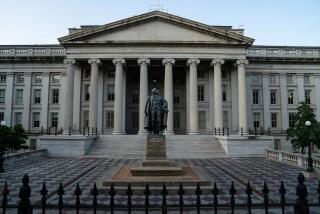Budget Surplus Guessing Game
- Share via
As projections of a federal surplus rise, and they do with every new forecast, the clamor in Washington for tax cuts and new spending grows louder. But the higher projected surplus remains nothing more than a paper gain. The fact that the forecasts can double from one year to the next points to the wobbly base on which they stand.
Figures released Tuesday by the Congressional Budget Office (CBO) indicate that the non-Social Security surplus over the next 10 years will total $1.92 trillion, nearly double the number it predicted last July, which, in turn, was $300 million higher than what the budget office predicted in April. This suggests the difficulty--some would say the impossibility--of making accurate economic projections 10 years ahead.
The CBO’s $1.92-trillion surplus assumes that government spending will stay within the 1997 caps accepted by Congress and the White House for five years; after 2002 the caps will rise at the rate of inflation. If spending remains at the 2000 level--rather than the 1997 level--and rises only with inflation, the CBO’s surplus projection will drop to $838 billion.
But Congress and the White House have never honored the 1997 limit, which makes the $1.92-trillion projection unrealistic anyway. In the current fiscal year, spending exceeds the cap by more than $30 billion, and Congress would have to slash discretionary spending by more than 20% to meet the 2002 limits. Clearly, much of the surplus is already being spent, leaving little room for tax cuts or new spending programs.
Another key assumption the CBO has made to establish the whopping surplus is that the economy will continue to grow for the next decade, 3% annually for the next two years and 2.7% each year thereafter, and that inflation will remain subdued.
It is the unprecedented performance of the U.S. economy over the last decade that accounts for the surplus. But how realistic is it to expect the good times to last for another decade, considering the economic imbalances already showing up in the record-breaking trade deficit and the growing indebtedness of consumers and private enterprises?
President Clinton said Tuesday he plans to use a good portion of the surplus to pay down the $3.6-trillion national debt. Paying off the debt would free up the more than $200 billion in debt interest that the government is paying each year, and this money could be used for capital spending. It would also make it easier for the government to borrow later.
Promising tax cuts or new entitlement programs sounds good in an election year, but it’s imprudent, despite the higher figures the Congressional Budget Office came up with.
More to Read
Inside the business of entertainment
The Wide Shot brings you news, analysis and insights on everything from streaming wars to production — and what it all means for the future.
You may occasionally receive promotional content from the Los Angeles Times.










